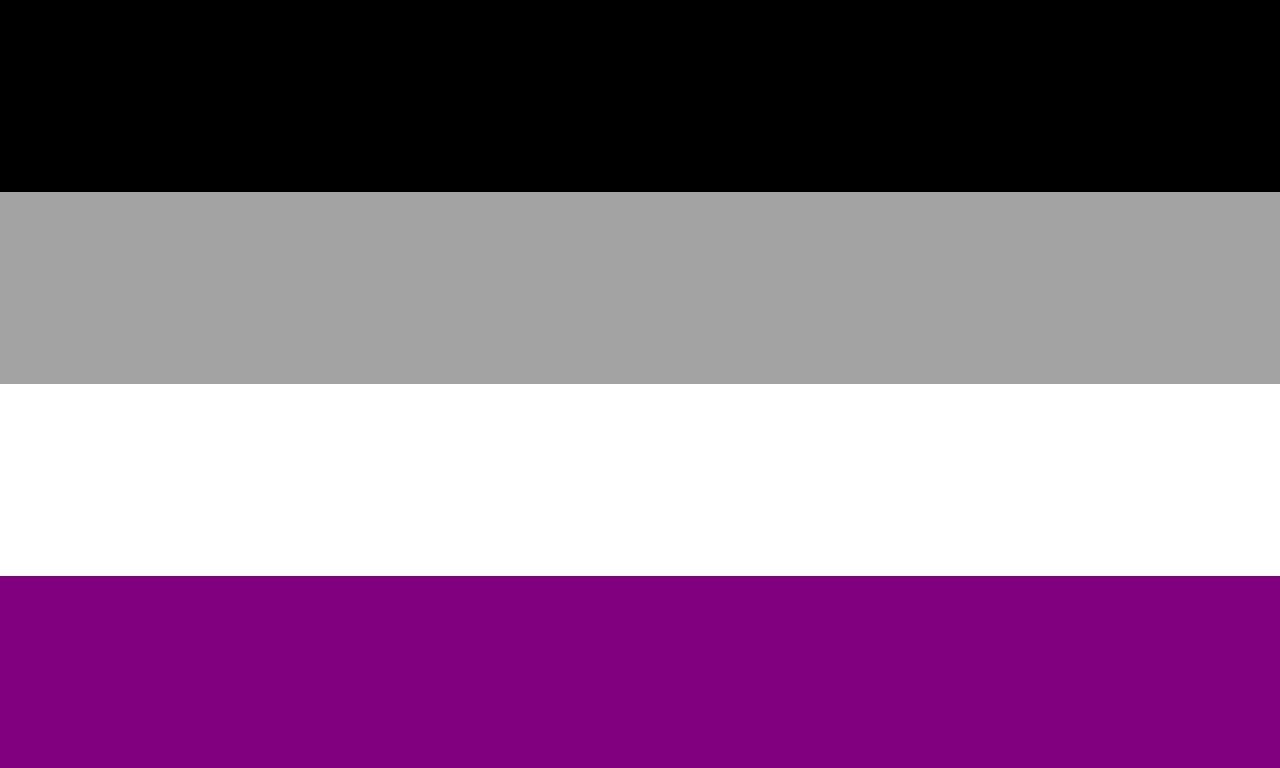Creating any awareness about asexuality is nearly impossible because of taboos and regressive ideas around discussions about sex, expressing one’s sexuality or desire, and that sex is immoral. Contrastingly, there is a misconception that asexuality is a convenience or even a privilege, or otherwise boring or lonely owing to the predominance of heteronormativity.

Asexuality pride flag. The black stripe in the flag represents asexuality, gray denotes gray-asexuality, white allosexuality, and purple, community. (Wikimedia Commons)
Societal norms about sex and sexuality are ingrained so deeply in many people that someone rejecting those is considered less of their gender or even less of a human sometimes.
Asexuality, thus, is pathologised and stigmatised as a sexual anomaly, hormonal deficiency, and/or a mental/psychological disorder.
When we started “coming out”, many of our friends were supportive, ready to listen to us, and open to our experiences as an asexual person. However, we have heard comments like, “Maybe you just need to wait for the right person to come into your life to feel anything sexual” and “Maybe you should try talking to a therapist” indicating that it can be ‘cured’ with therapy and “maybe, you have experienced some sexual
trauma which caused this”.
Asexuality and language keep having a weird relationship. While asexuality is defined as an absence or variability of sexual attraction, desire, or arousal, sexuality is not limited to attraction, desire, or arousal. Rather, sexuality denotes vast and expansive ways through which people
experience and express themselves sexually.
Hence the word asexual is limiting, and many of us from the community prefer using the word ‘Ace’ to define our experiences. But the weirdness with the language does not stop there. Predominantly, ‘Ace’ highlights the kind of intimacy the person is seeking. In other terms, our Aceness helps us communicate and connect with people whom we care about.
We believe that irrespective of curiosity about and care for others, the dominant presumption that asexuality is impossible, unnatural, and abnormal minimises awareness and acceptance of it, even among LGBTQIAP+ persons. We struggled for a long time to accept
our asexuality not only because of the minimality of access to relevant information (oral, visual, or textual, in a physical or digital form) but also because of the ignorance about the existence of any information about asexuality or other Aces.
Another issue we Aces contend with is the (mis)representation and misinformation about asexuality and the hyper-sexualization present in “popular” culture and media. The constant messaging around marriage, sex, and starting a family in movies, music, literature, ads and
conversations reduce the understanding of Aces as being ascetics or saints.
In other words, asexuality is conflated with celibacy, prudery, de-sexualisation, and abstinence.
Creating any awareness about asexuality is nearly impossible because of taboos and regressive ideas around discussions about sex, expressing one’s sexuality or desire, and that sex is immoral. Contrastingly, there is a misconception that asexuality is a convenience or even
a privilege, or otherwise boring or lonely owing to the predominance of heteronormativity.
In more extreme situations, Aces are forced to undergo “corrective” rape or “conversion” therapy without recourse, which is prohibited and punishable.
Awareness is important across heterosexual and LGBTQIAP+ spaces. A in LGBTQIAP+ is not an ally. It is asexual, agender, and aromantic, and several more invisible identities in the LGBTQIAP+ spectrum.
If we don’t talk about Aceness, we stay invisible. Hence we take space and assert our identities. But this should be a shared responsibility. It is on everyone to hold that space for us and other marginalised identities through education and interactions spanning across local languages and not just in English.
Currently, conversations among/about Aces are largely in English or Hindi, as there is a lack of regional terminology, thereby limiting Ace
awareness.
Continuous internet and English fluency supported our self-questioning. A lack of these privileges can make it nearly impossible to come across the term asexual, understand, and access the Ace community, even when the Ace experience is prevalent everywhere.
Consequently, we, Aces, may be subject to compulsory sexualisation and forced to have sex when we are not interested. We Aces may have our experiences or emotions invalidated or reject ourselves, causing us severe physical and mental health issues.
Asexuality, just by existing, defies the notion of compulsory sexualization, which presumes that every person needs to be sexually active. Even LGBTQIAP+ spaces and movements largely endorse the notion of compulsory sexualization, which makes asexuality invisible.
The hesitation to include Aces, coupled with ignorance and arrogance that something/someone different is inhuman, makes it difficult for asexuality to take up space in discussions.
As Aces, we now ask questions back to you: What is sexual attraction according to you? Taking sex off the table, what would you say is the difference between a friend and a partner? Is sexual attraction required to have sex with another consenting adult? Otherwise, what is the role of sexual attraction? Is the presence or absence of sexual attraction related to other aspects of a person?
Ask yourself these questions. Now let us ask you this, again: Would you think about asexuality the same way again?
(Ritash is a writer, LGBTQIAP+ peer counsellor, and co-founder of the RANG Foundation; Sweta D is a research scholar and LGBTQIAP+ peer counsellor; and Lakshmi V, a researcher, writer, and post-graduate student in Sociology. Views expressed are of the authors. Edited by Majnu Babu).
